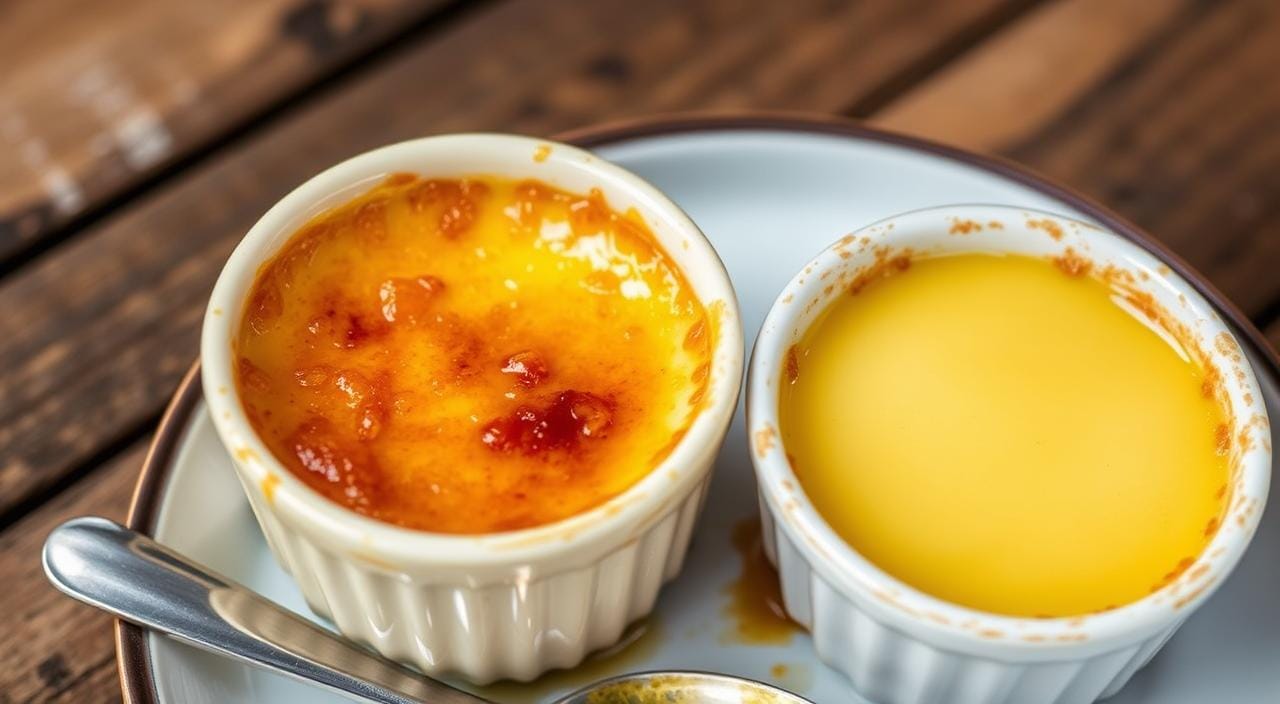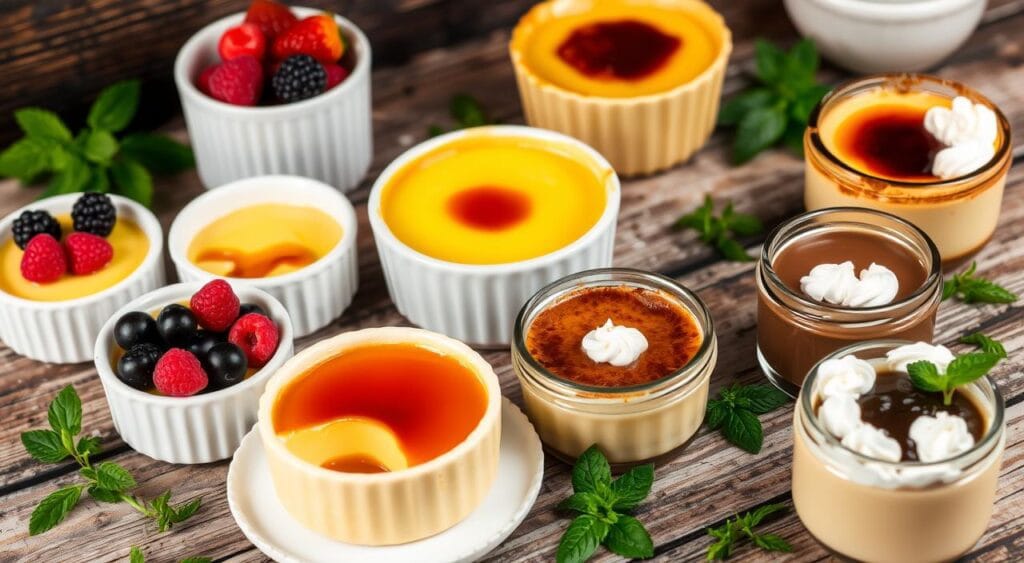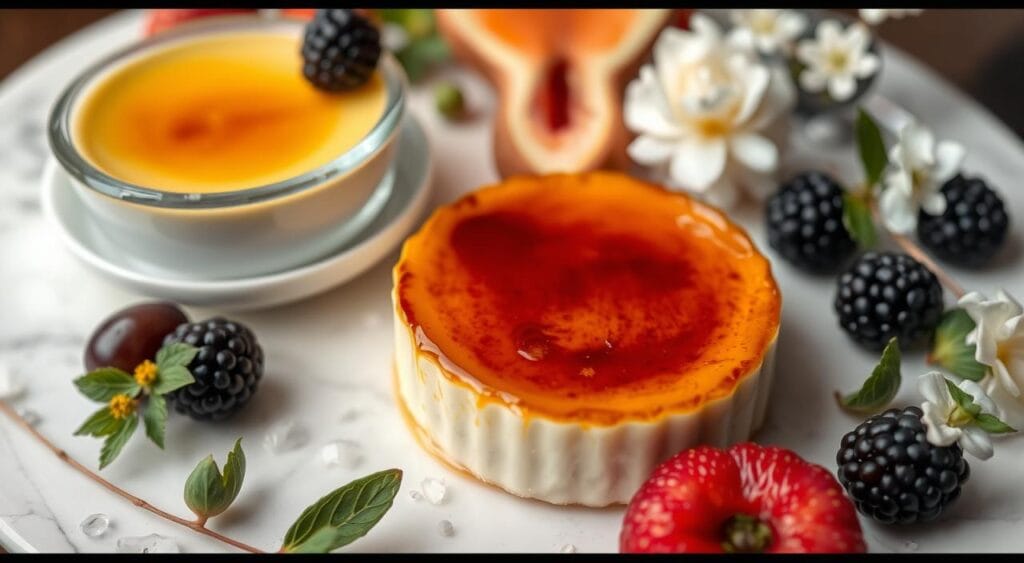Custard’s creamy texture and sweet taste pair wonderfully with a variety of flavors. For a sweet and tangy combination, try it with fresh fruits like apples or berries. For a unique twist, add crunchy elements such as nuts or crumbled cookies to create a delightful contrast with the smooth custard.I love desserts, and I’m always curious about the differences between crème brûlée and custard. These two desserts are big in French cuisine. They have their own special textures, tastes, and ways of making them. Knowing the differences between them can make you appreciate pastry-making even more.
Key Takeaways:
- Crème brûlée and custard are both egg-based desserts, but they differ in their texture, flavor profile, and cooking techniques.
- Crème brûlée features a creamy custard base topped with a caramelized sugar crust, while custard has a smooth, silky consistency without the crunchy topping.
- The use of sugar and the method of cooking are the primary factors that differentiate these two beloved desserts.
- Crème brûlée originated in France, while custard has a longer history, dating back to ancient times and various culinary traditions.
- Both crème brûlée and custard offer a range of delightful variations, catering to diverse palates and preferences.
Understanding Crème Brûlée
Crème brûlée is a favorite French dessert loved by many. It’s known for its creamy custard and caramelized sugar topping. This topping adds a nice crunch and sweet flavor.
Origin of Crème Brûlée
Crème brûlée started in 17th century France as a simple custard. The caramelized sugar topping was added later. This made it the famous dessert we know today.
Ingredients Used in Crème Brûlée
The main ingredients are heavy cream, egg yolks, sugar, and vanilla. The cream makes it smooth, while egg yolks add creaminess. Sugar is for the caramel topping, and vanilla gives it a nice smell and taste.
The Cooking Method for Crème Brûlée
To make crème brûlée, a special method is carefully employed. First, it is baked in ramekins placed in a water bath, which ensures even cooking and a perfectly smooth texture. After baking, sugar is evenly sprinkled on top and caramelized with a culinary torch, creating a golden, crunchy layer that beautifully complements the creamy custard beneath.
What is Custard?
Custard is a creamy, egg-based dessert loved by many around the world. Interestingly, its origins trace back to ancient Rome and medieval Europe, showcasing a rich and fascinating history. Today, custard continues to be a comforting treat, enjoyed globally in a variety of delightful forms.
Historical Background of Custard
To begin with, ancient Roman cooks were the first to make a milk-based pudding. Over the centuries, this humble dish evolved and became a favorite in medieval Europe. Moreover, the introduction of new techniques and ingredients, such as eggs, greatly enhanced the flavor and texture of custard.
Types of Custard
In modern times, custard is available in many forms, each offering its own unique taste and preparation method. Let’s explore a few common types:
- Baked Custard: This classic custard is made by baking a mixture of eggs, milk, and sugar in a water bath, resulting in a firm yet creamy texture.
- Stirred Custard: Often referred to as “crème anglaise,” this variation is cooked on the stovetop, offering a smooth and velvety consistency.
- Frozen Custard: Finally, this variation transforms a custard base into a rich and creamy ice cream through churning.
Basic Ingredients in Custard
The foundation of any custard lies in its main ingredients: eggs, milk, and sugar. Together, these simple components create the delicious custard desserts we all adore. Additionally, the method of mixing and cooking these ingredients can vary, giving rise to a variety of egg-based desserts and baked custard recipes.
Key Differences Between Crème Brûlée and Custard
Crème brûlée and custard may look similar, but they are quite different. Let’s explore what makes them unique.
Texture and Consistency
Crème brûlée is known for its creamy texture and a caramelized sugar top. This top adds a nice contrast when you crack it with a spoon. Custard, however, is softer and smoother, often described as velvety.
The sugar crust in crème brûlée makes it firmer. Custard stays soft and easy to spoon.
Flavor Profile
Crème brûlée tastes mainly of vanilla, with a rich cream and egg yolk flavor. The caramelized sugar adds a sweet and smoky taste. Custard, while sweet, has a milder flavor. It can also include vanilla, lemon, or chocolate.
Cooking Techniques
Crème brûlée is baked, then chilled, and finally topped with caramelized sugar. This is done by torching or broiling the surface. Custard, however, is baked or steamed until it’s custard-like. It doesn’t have a hardened sugar topping.
| Characteristic | Crème Brûlée | Custard |
|---|---|---|
| Texture | Silky, creamy with a caramelized sugar topping | Soft, velvety, and spoonable |
| Flavor | Vanilla-forward with a caramelized sweetness | Mellow, subtly sweet with potential for additional flavors |
| Cooking Technique | Baked, then topped with caramelized sugar | Baked or steamed until the desired custard texture is achieved |
Knowing these differences helps you enjoy both crème brûlée and custard more. You can pick the one that fits your taste and the event.
The Role of Sugar in Each Dessert
Sugar is key in crème brûlée and custard desserts. It shapes their unique tastes. Let’s explore how sugar is used in these favorites.
Sugar in Crème Brûlée
The golden, caramelized sugar layer is undoubtedly what truly defines crème brûlée, setting it apart as a dessert masterpiece. Moreover, this crisp, crackling crust crowns the creamy custard beneath, creating a harmonious balance of textures and flavors. Achieved by melting sugar with a torch or broiler, it ultimately delivers the dessert’s iconic finish.
Furthermore, the contrast between the smooth, velvety custard and the crunchy caramelized sugar is nothing short of extraordinary. This delightful interplay not only adds a sweet and satisfying touch but also makes every bite a truly memorable experience.
Sugar in Custard
In custard desserts, sugar adds sweetness and richness. Unlike crème brûlée, sugar in custard is mixed into the base. It melts with eggs and milk or cream.
This makes the custard sweet and balanced. It’s a key part of traditional custard dishes.
“The interplay between the caramelized sugar and the silky custard is what makes crème brûlée so irresistible.”
Popular Variations of Crème Brûlée
The classic crème brûlée is a true gem of French cuisine. Talented chefs have reinvented this beloved dessert. While the original recipe is timeless, exploring different interpretations can add excitement to your culinary adventures.
Chocolate Crème Brûlée
For those who love rich, indulgent flavors, the chocolate crème brûlée is a must-try. It infuses the custard base with high-quality chocolate. This makes the dish even more decadent.
The creamy, chocolatey interior contrasts beautifully with the caramelized topping. This creates a harmonious symphony of textures and tastes.
Fruit-Flavored Crème Brûlée
- Citrus-Infused Crème Brûlée: This version adds a tangy twist with the zest and juice of lemons, limes, or oranges.
- Berry Crème Brûlée: Swirling raspberries, blackberries, or a mix of berries into the custard adds a vibrant, fruity element.
- Tropical Crème Brûlée: Pineapple, mango, or passion fruit can transport your taste buds to a tropical oasis, creating a unique and flavorful take on the classic crème brûlée.
These creative variations on crème brûlée not only satisfy the palate but also delight the eyes with their stunning presentations. Whether you prefer the rich chocolate indulgence or the refreshing fruit-forward flavors, these adaptations showcase the versatility and enduring appeal of this French cuisine staple.
Unique Custard Variations You Should Try
The classic custard dessert is indeed delightful. But, there are many unique custard-based creations worth trying. Pastry cream and bread pudding are two standout examples. They show how versatile this egg-based dessert can be.
Pastry Cream
Pastry cream, also known as crème pâtissière, is a rich custard. It’s the base for many classic French pastries. It’s made by gently cooking a mix of milk, eggs, sugar, and cornstarch until it thickens.
This custard dessert becomes a smooth, pudding-like consistency. It’s a versatile filling for éclairs, cream puffs, tarts, and even layered cakes.
Bread Pudding
Bread pudding is a comforting custard dessert that evokes warmth and nostalgia. Traditionally, it is prepared by soaking cubes of day-old bread in a luscious custard mixture, often infused with flavors such as vanilla, cinnamon, or chocolate.
During baking, the bread absorbs the custard, resulting in a soft, custardy texture with a lightly crisp and golden top. This beloved egg-based dessert is celebrated for its versatility, as it can be enjoyed warm or chilled, making it a delightful treat for any season or occasion.
Whether you’re in the mood for a classic custard or want to try something new, these unique variations will delight you. They show the versatility of custard desserts and egg-based desserts.
How to Serve Crème Brûlée
Serving crème brûlée is an art that makes dining special. It has a creamy base and a caramelized top. The way it’s presented is as important as its taste.
Presentation Tips
To serve crème brûlée with style, follow these tips:
- Use ramekins or small dishes to show off the dessert’s beauty.
- Make sure the sugar topping is perfectly caramelized for a golden crust.
- Add a sprig of fresh mint, powdered sugar, or a fruit slice for a pop of color.
- Keep the dessert cold. The warm top and cool custard are part of the fun.
Pairing Suggestions
Crème brûlée goes well with many flavors and drinks. Here are some great pairings:
| Pairing | Why it Works |
|---|---|
| Espresso or strong coffee | The dark coffee contrasts well with the creamy dessert. |
| Fruit-forward dessert lemon | A sweet lemon like Sauternes or Muscat complements the dessert’s rich taste. |
| Fresh berries | Berries like raspberries or blackberries balance the dessert’s richness. |
By focusing on presentation and pairing, you can make crème brûlée even more special. It’s a classic French cuisine treat that’s sure to impress.
Serving Custard: Best Practices
Serving custard desserts right can make your meal special. It’s all about how you present it and what you pair with it. Let’s look at the top ways to serve this classic baked custard treat.
Presentation Ideas
There are many ways to make custard look great. Try serving it in individual ramekins or small dishes. This lets everyone enjoy their own piece. You can also get creative with toppings like fresh fruit or a sprinkle of cinnamon.
- Serve custard in individual ramekins or small dishes for a sophisticated presentation.
- Layer the custard with fresh berries or a compote for a delightful contrast of textures and flavors.
- Garnish the custard with a light dusting of spices, such as cinnamon or nutmeg, for an added touch of elegance.
Ideal Pairings for Custard
Custard’s creamy texture and sweet taste make it great with many flavors. Try it with fresh fruit like apples or berries for a sweet and tangy mix. For something different, add crunchy elements like nuts or cookies to contrast with the smooth custard.
| Custard Pairing | Flavor Profile |
|---|---|
| Fresh Berries | Sweet and tart flavors that complement the creamy custard. |
| Caramelized Fruit | The sweetness of caramelized fruit enhances the custard’s creaminess. |
| Crunchy Nuts | Toasted nuts add a delightful textural contrast to the smooth custard. |
By focusing on presentation and pairings, you can make a memorable custard-based meal. It’s all about the details.
Common Nutritional Differences
When we look at crème brûlée and custard, two beloved egg-based desserts, we see big nutritional differences. Both are rich treats, but they have different calorie counts, sugar levels, and fat types.
Caloric Content Comparison
A serving of crème brûlée contains approximately 300–400 calories, depending on the recipe and portion size. In contrast, custard typically has 200–300 calories per serving. The higher calorie count of crème brûlée is primarily due to its use of heavy cream and the caramelized sugar topping.
Sugar and Fat Content Analysis
| Nutritional Aspect | Crème Brûlée | Custard |
|---|---|---|
| Sugar Content | 25-30 grams per serving | 15-20 grams per serving |
| Fat Content | 18-22 grams per serving | 12-16 grams per serving |
Crème brûlée has more sugar and fat because of heavy cream and caramelized sugar. Custard has a better balance of sugar and fat.
“Understanding the nutritional differences between crème brûlée and custard can help you make more informed choices when indulging in these delectable egg-based desserts.”
Why People Love Each Dessert
The love for crème brûlée and custard desserts stems from their unique qualities and irresistible appeal. Additionally, these delightful treats have captured hearts worldwide, with each offering its own distinctive charm. Furthermore, they cater to a variety of tastes and preferences, solidifying their place as timeless favorites.
Popularity of Crème Brûlée
Crème brûlée is cherished for its elegance and refined sophistication. Moreover, it remains a favorite in upscale restaurants and among dessert enthusiasts. Its charm, in particular, lies in the delightful contrast of textures: a silky, creamy custard beneath a crisp, caramelized sugar crust that cracks perfectly with a spoon, creating a truly satisfying experience.
Custard’s Comfort Food Appeal
Custard desserts are loved for their comfort and nostalgia. They often remind us of cherished childhood memories and the warmth of homemade treats. Furthermore, custard’s versatility allows it to transform into various delights, ranging from creamy puddings to delicate tarts, with each offering a unique and satisfying experience.
Similarly, crème brûlée and custard desserts continue to win hearts worldwide. They are, without a doubt, timeless classics in the world of sweets, celebrated for their enduring charm and universal appeal.
Final Thoughts: Choosing Between Crème Brûlée and Custard
Both crème brûlée and custard are beloved French desserts. They share some similarities but also have
Custard desserts hold a special place in our hearts, offering comfort and nostalgia that often bring back cherished memories of childhood and homemade treats. Moreover, their incredible versatility allows them to take on various forms, ranging from creamy puddings to elegant tarts, with each providing a delightful and unique experience.
Similarly, crème brûlée and custard desserts have an enduring appeal, as they continue to capture the hearts of dessert lovers worldwide. Consequently, these timeless classics remain celebrated for their charm, sophistication, and irresistible flavors.
their own unique qualities. Think about the occasion, your taste, and any dietary needs when choosing.
When to Serve Each Dessert
Crème brûlée is known for its caramelized sugar and creamy texture. It’s perfect for fancy dinners or special events. Custard, with its cozy feel, is great for casual get-togethers or a simple dessert.
Personal Preference Considerations
The choice between crème brûlée and custard often depends on what you like. Crème brûlée offers a unique mix of textures and a showy presentation. Custard, on the other hand, is smooth and has a milder taste. Think about what you and your guests will enjoy most.
FAQ
WHAT’S THE DIFFERENCE BETWEEN CRÈME BRÛLÉE AND CUSTARD?
Crème brûlée and custard differ in texture, flavor, and preparation. Crème brûlée features a creamy custard base with a caramelized sugar crust, while custard is softer and made with eggs, milk, and sugar, either baked or stirred.
WHAT ARE THE KEY INGREDIENTS USED IN CRÈME BRÛLÉE?
The essential ingredients for crème brûlée are heavy cream, egg yolks, sugar, and vanilla. It is baked in a water bath and finished with a caramelized sugar layer.
WHAT IS THE HISTORICAL BACKGROUND OF CUSTARD?
Custard originated in ancient Europe as a way to utilize excess eggs. Over time, it evolved into various desserts, including baked, stirred, and frozen custards.
HOW DOES THE TEXTURE AND CONSISTENCY DIFFER BETWEEN CRÈME BRÛLÉE AND CUSTARD?
Crème brûlée is dense and creamy, topped with a crunchy caramelized sugar layer. Custard is softer, with a more delicate consistency.
WHAT IS THE ROLE OF SUGAR IN CRÈME BRÛLÉE AND CUSTARD?
In crème brûlée, sugar creates the signature caramelized topping. In custard, it sweetens the mixture and enhances the overall flavor.
WHAT ARE SOME POPULAR VARIATIONS OF CRÈME BRÛLÉE?
Popular variations include chocolate crème brûlée, fruit-infused versions like raspberry or orange, and even coffee-flavored crème brûlée. These variations keep the classic custard base with a caramelized topping.
WHAT ARE SOME UNIQUE CUSTARD-BASED DESSERTS TO TRY?
Explore desserts like pastry cream, used in tarts and éclairs, or bread pudding, which combines custard with bread for a comforting treat.
HOW SHOULD CRÈME BRÛLÉE AND CUSTARD BE SERVED?
Crème brûlée is best served in ramekins, showcasing its caramelized sugar topping. Custard can be served in cups, bowls, or as a base for layered desserts, often complemented by additional flavors or toppings.
What are the common nutritional differences between crème brûlée and custard?
Crème brûlée has more calories and fat from heavy cream. Custard is lower in calories and fat but may have more sugar.
Why are crème brûlée and custard so popular?
Crème brûlée’s creamy custard and caramelized sugar are loved. Custard’s comfort and versatility make it a classic favorite.
For more ideas to enhance your next special dinner, try these recipes that will impress your guests and make any meal memorable:



